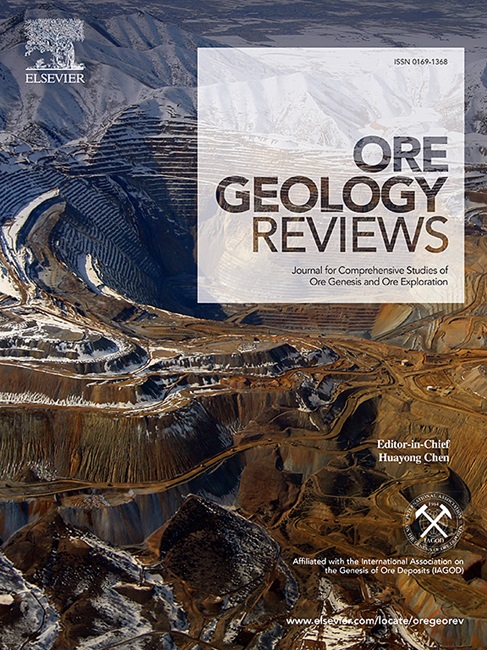中国河南省西部下坪沟角砾岩型金矿床的成因
IF 3.2
2区 地球科学
Q1 GEOLOGY
引用次数: 0
摘要
华北克拉通(NCC)内的角砾岩赋存金矿床显示出复杂的成因,一些角砾岩与金矿化在成因上有关联,而另一些则没有关联。了解这些角砾岩的成因对于阐明伴生矿床的成因和指导勘探战略至关重要。熊耳山地区的下坪沟矿床位于新中国成立后的南缘,由石英碳酸盐岩脉型银铅锌金矿床和相关的角砾岩管组成,赋存于晚阿尔川世至早古生代太华组的变质岩中。下坪沟角砾岩的成因对于了解下峪银-铅-锌-金矿化(5640 吨银)至关重要。 在本研究中,我们从下坪沟矿床的特征、角砾岩特征、角砾岩赋存的金矿化以及同位素数据中汲取了新的见解,研究了角砾岩与银铅锌金矿化之间的遗传关系。这些发现加深了我们对下坪沟银铅锌金热液系统的了解,并完善了不和谐角砾岩管道的勘探模型。最近的地下隧道勘测和钻探岩芯测井揭示了角砾岩与隐伏花岗斑岩之间的密切空间联系。在花岗斑岩apophysis上方的角砾岩管中存在幼年岩浆碎屑(花岗斑岩)和胶结物(花岗斑岩中结晶的钾长石和石英),表明角砾岩是由花岗斑岩成岩引起的相岩浆角砾岩化形成的。厘米至 100 米尺度的流体化显示,在隐爆之后,角砾岩管内部的碎屑移动方向是西北至东南,形成了一个西北走向的角砾岩带。角砾岩中黄铁矿包裹的正方体独居石(131.2 ± 7.6 Ma)限制了角砾岩化的上限。岩粉和热液胶结物中黄铁矿的δ34S值分别为3.8‰至5.3‰(平均值:4.8‰)和2.7‰至7.5‰(平均值:5.2‰),热液胶结物中的δ34S-闪锌矿的范围分别为5.7‰至6.1‰(平均值:5.9‰),δ34S-黄铜矿的范围为-0.9‰至5.6‰(平均值:2.9‰)。脉托成矿带和角砾岩托成矿带的 S 同位素特征是一致的,硫化物组合和蚀变特征完全一致。这些证据共同表明,岩脉和角砾岩矿化带都是岩浆活动的产物。下坪沟角砾岩管的成矿模式强调了其独特的形成机制,即由先前存在的西北走向构造薄弱环节和流化作用所驱动。这一模型意味着碎屑主要是由西北向东南方向运移,并提出了深部潜在斑岩型金矿化系统的假设。本文章由计算机程序翻译,如有差异,请以英文原文为准。

Genesis of the Haopinggou breccia-hosted Au deposit, western Henan Province, China
Breccia-hosted Au deposits within the North China Craton (NCC) exhibit a complex genesis, with some breccias being genetically linked to Au mineralization and others unrelated. Understanding the origin of these breccias is crucial for elucidating the genesis of associated ore deposits and guiding exploration strategies. The Haopinggou deposit in the Xiong’ershan district, on the southern margin of the NCC, comprises quartz-carbonate vein-hosted Ag–Pb–Zn–Au deposits and related breccia pipe in metamorphic rocks of the late Archean to early Paleoproterozoic Taihua Group. The origin of the Haopinggou breccia is crucial to understand the Xiayu Ag-Pb-Zn-Au mineralization (5640 t Ag). In this study, we examine the genetic relationship between breccia and Ag‒Pb‒Zn‒Au mineralization, drawing on new insights from the characteristics of the Haopinggou deposit, breccia features, breccia‒hosted Au mineralization, and isotopic data. These findings enhance our understanding of the Haopinggou Ag‒Pb‒Zn‒Au hydrothermal systems and refine exploration models for discordant breccia pipes. Recent underground tunnel surveys and drill-core logging reveal a close spatial link between the breccia and hidden granite porphyry. Juvenile magmatic clasts (granite porphyry) and cement (K-feldspar and quartz crystallized from granite porphyry) are present in the breccia pipe above a granite porphyry apophysis, indicating that the breccia was formed by phreatomagmatic brecciation caused by emplacement of the granite porphyry. Fluidization at the cm- to 100-m-scale reveals that the movement direction of clasts inside the breccia pipe was from northwest to southeast after crypto-explosion, creating a northwest-trending breccia zone. Anhedral monazite (131.2 ± 7.6 Ma) encapsulated in pyrite from the breccia constrains the upper limit of brecciation. The δ34S values of pyrite in rock flour and hydrothermal cements range from 3.8 ‰ to 5.3 ‰ (mean: 4.8 ‰) and 2.7 ‰ to 7.5 ‰ (mean: 5.2 ‰), respectively, with δ34S-sphalerite in hydrothermal cement ranging from 5.7 ‰ to 6.1 ‰ (mean: 5.9 ‰) and δ34S-chalcopyrite ranging from − 0.9 ‰ to 5.6 ‰ (mean: 2.9 ‰). The S isotope characteristics of vein-hosted and breccia-hosted mineralization zones are consistent, with complete alignment of the sulfide assemblages and alteration features. These pieces of evidence collectively indicate that both vein- and breccia-hosted mineralization zones are products of magmatic activity. The metallogenic model for the Haopinggou breccia pipe underscores its unique formation mechanism, driven by pre-existing northwest-striking structural weaknesses and fluidization. This model implies a predominant northwest‒to‒southeast transport of clasts and raises the hypothesis of an underlying porphyry‒type Au mineralization system at depth.
求助全文
通过发布文献求助,成功后即可免费获取论文全文。
去求助
来源期刊

Ore Geology Reviews
地学-地质学
CiteScore
6.50
自引率
27.30%
发文量
546
审稿时长
22.9 weeks
期刊介绍:
Ore Geology Reviews aims to familiarize all earth scientists with recent advances in a number of interconnected disciplines related to the study of, and search for, ore deposits. The reviews range from brief to longer contributions, but the journal preferentially publishes manuscripts that fill the niche between the commonly shorter journal articles and the comprehensive book coverages, and thus has a special appeal to many authors and readers.
 求助内容:
求助内容: 应助结果提醒方式:
应助结果提醒方式:


